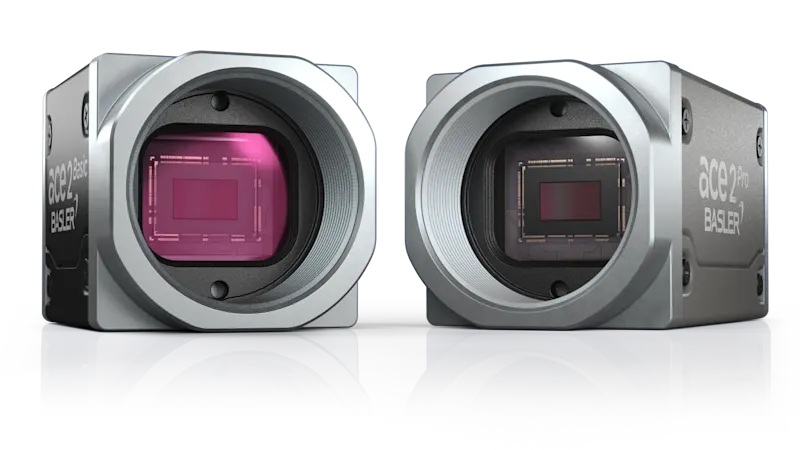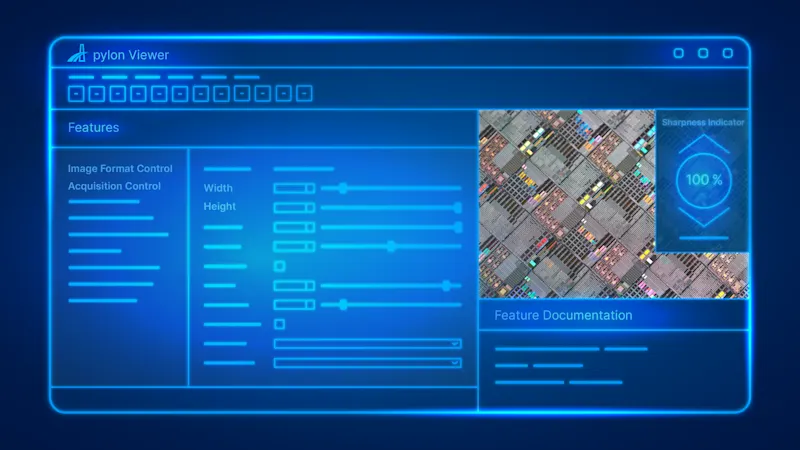Basler ace 2 a2A2048-37gmPRO
- IMX900 Sensor
- 37 fps Frame rate
- GigE Interface
- 3.2 MP Resolution (MP)
- 1/3.1'' Sensor Format
The Basler a2A2048-37gmPRO GigE camera with the Sony IMX900 CMOS sensor delivers 37 frames per second at 3.2 MP resolution.
Select Product Line:
General Information
| Manufacturer | Basler |
|---|---|
| Order Number | 109472 |
| Product Family | ace 2 R |
| Product Line | ace 2 R Pro |
| Camera Series | Basler ace 2 |
| Camera Category | Area Scan Camera |
| Warranty | 36 Months |
Sensor
| Sensor Vendor | Sony |
|---|---|
| Sensor | IMX900 |
| Shutter | Global Shutter |
| Sensor Format | 1/3.1'' |
| Sensor Diagonal | 5.81 mm |
| Sensor Type | CMOS |
| Sensor Size | 4.61 mm × 3.46 mm |
| Resolution (H x V) | 2048 px × 1536 px |
| Resolution | 3.2 MP |
| Pixel Size (H x V) | 2.25 μm × 2.25 μm |
| Frame rate | 37 fpsCalculate individual frame rate |
| Frame Rate Compression Beyond | up to 100 fps |
| Mono/Color | Mono |
| Spectrum | Visible |
EMVA Data
| Quantum Efficiency (typical/minimal) | 86.8 % (typical) |
|---|---|
| Dark Noise (typical/maximal) | 5.3 e¯ (typical) |
| Saturation Capacity (typical/minimal) | 11.3 ke¯ (typical) |
| Dynamic Range (typical/minimal) | 64.5 dB (typical) |
| Signal-to-Noise Ratio (typical/minimal) | 39.9 dB (typical) |
Camera Data
| Interface | GigE |
|---|---|
| Image Data Interface | Fast Ethernet (100 Mbit/s), Gigabit Ethernet (1000 Mbit/s) |
| Pixel Bit Depth |
|
| Synchronization |
|
| Exposure Control |
|
| Digital Input | 1 |
| General Purpose I/O | 2 |
| Power Supply | PoE or 12-24 VDC |
Housing
| Housing Type | Box |
|---|---|
| Protection Class | IP30 |
| Housing Size (L x W x H) | 55.5 mm x 29 mm x 29 mm |
| Weight | 105 g |
| Lens Mount | C-mount |
| Operating Temperature | -10 °C - 50 °C |
Technical Drawing
Manufacturer
| Basler |
|---|
Conformity
- CE (incl. RoHS)
- EAC
- FCC
- GenICam
- GigE Vision 2.0
- IP30
- KC
- RoHS
- UKCA
- UL (in preparation)
High Sensitivity, High Dynamic Range & Flexible Lens Selection
The IMX900 sensor is characterized by high sensitivity – even in the near-infrared (NIR) range – and a high dynamic range. It also allows for flexible lens selection. Thanks to these features, cameras with the IMX900 sensor can be used in a variety of ways and are particularly well suited for ITS, food, logistics, and 3D applications.
High sensitivity in the visible & NIR range
The graph shows the quantum efficiency (QE) of three sensors.
IMX900: Global shutter sensor, 3.2 MP resolution, pixel size of 2.25 μm2, latest Sony Pregius S technology
IMX252: Global shutter sensor, 3.1 MP resolution, pixel size of 3.45 μm2, Sony Pregius 2 technology
CMV2000NIR: NIR-optimized global shutter sensor, 2.2 MP resolution, pixel size of 5.5 μm2, discontinued sensor
The QE curves prove the high sensitivity of the IMX900 sensor in the visible and NIR range compared to the established reference sensors.

High dynamic range
The IMX900 sensor features Quad High Dynamic Range (Quad HDR) functionality. This allows images to be taken simultaneously under different exposure conditions, increasing the dynamic range up to 120 dB. As a result, images of materials with different reflectivity (such as metal parts and rubber materials) improve significantly.
High flexibility in lens selection
Thanks to its 2.25 μm small pixels, the IMX900 is a compact 1/3.1" sensor that captures more light than the IMX252, for example, due to its improved pixel architecture. This allows for shorter exposure times while maintaining the same image quality, or the use of a wider aperture to achieve more depth of field. As a result, there is greater flexibility in the choice of lenses.
Unlike the IMX252, both the Basler C125 lenses and the Basler C23 lenses are available for cameras with the IMX900. The best image quality is provided by the Basler C23 lenses, due to low vignetting and distortion.
Increase image brightness without the loss of image structures
The High Conversion Gain feature of the IMX900 sensor allows image brightness to be increased in situations where gain is unavoidable—without affecting the precise detection of fine structures or edges.
Technical background: Further development of pixel architecture
The novel pixel architecture of the IMX900 sensor (based on Sony Pregius S technology) leads to an increased angle of incidence of light. This increases the amount of light captured – even in low-exposure applications – and thus the QE. This allows the exposure time to be reduced while maintaining the same image quality. In addition, the improved pixel architecture increases sensitivity in the NIR range.
Features
For more information about the features, visit the Documentation
Easy Handling
| Auto Functions | Use the camera's auto functions to allow the camera to find the optimum settings for exposure time, gain, and white balance, for example. This simplifies camera integration into your application. |
| Presettings | Automate recurring steps in your application by using the camera's default settings and/or creating and saving your own presets. |
Image Quality Optimization
| High Dynamic Range (HDR) | Expand the dynamic range by up to 16 bit. This ensures that bright areas are reproduced precisely and without loss of information, while preserving details in dark areas. |
| Image Adjustment | Adjust pixel values losslessly with Black Level, Digital Shift, and other standard features. |
| Improvement of Image Quality | Reduce image artifacts caused by environmental influences. Correct individual pixel errors using Defect Pixel Correction. |
| PGI - Patented | Use the complete image enhancement package or choose from Denoising, Sharpness, Debayering, and Color-Anti-Aliasing to adjust the image quality. |
Process Control
| Burst Mode | Acquire a sequence of images after triggering once and output them as required. In High-Speed Burst Mode, you can temporarily bypass the data limitation of GigE. |
| Digital I/Os | Control the camera via trigger commands or use the camera to control components of your vision system, such as lighting or encoders. |
| Information Utilisation | Use additional information from Chunks and Events to optimize your automation. |
| Intelligent Light Control (SLP) | Control the lighting directly with the camera. By synchronizing the flash mode and adjusting the brightness levels, you can quickly achieve precise lighting conditions and shorten the development time of your application. |
| Sequencer | Program sequential processes in the camera to control image acquisition and pre-processing in real time. |
| Timing | Control the start and end of an exposure individually. Add delays or synchronize multiple cameras in a GigE network using PTP. |
Speed Increase
| Compression Beyond - Patented | Reduce the amount of image data transferred using our patented image compression algorithm and choose between 'lossless' and 'lossy'. |
| Data Reduction | Use the Binning, Decimation, or ROI features for customized data reduction. |
| Pixel Beyond - Patented | Use our patented Binning process to continuously adjust the sensor pixel to meet your needs. Reduce the amount of data or simulate the characteristics of another sensor. |
Suitable Products
Recommended software

All Basler ace 2 Models
Haven't found the right model? See the product list for an overview of all ace 2 models. Find the right product for your application: filter by sensor, resolution, frame rate, and more.





